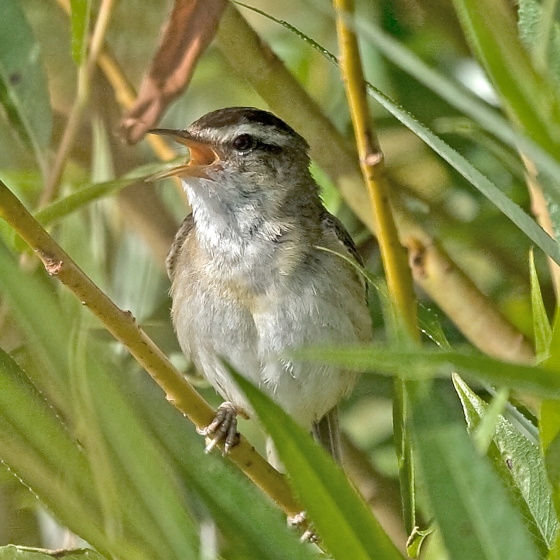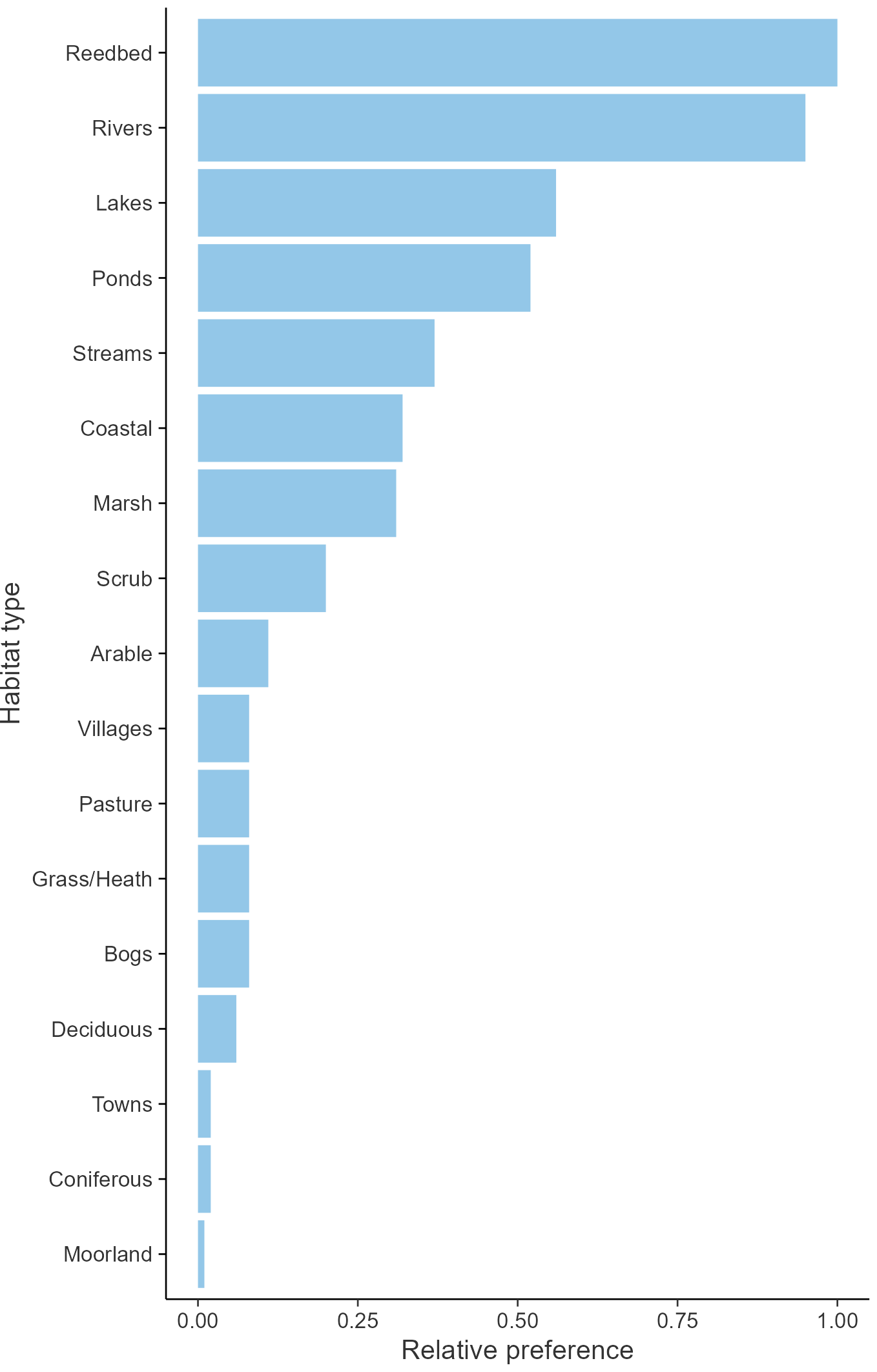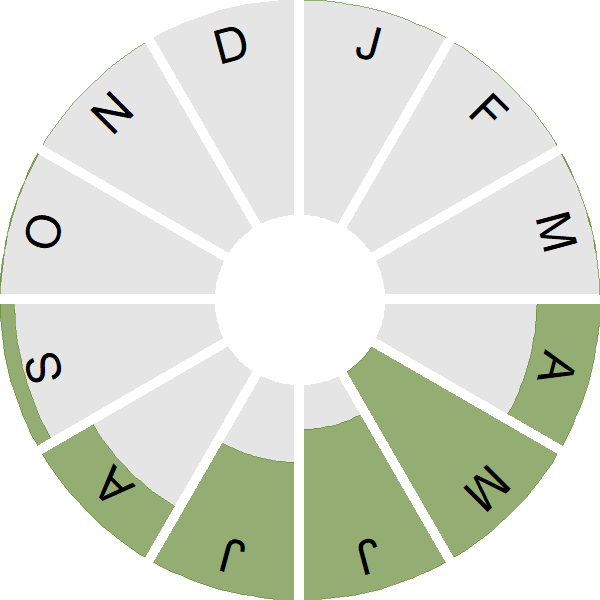Sedge Warbler

Introduction
The strong, pale supercilium, streaked upperparts and energetic song help identify this reedbed-edge, sedge-loving warbler.
The Sedge Warbler can be found breeding around wetland and marshy habitat across Britain & Ireland. Numbers fluctuate year to year, which is thought to be related to rainfall affecting adult survival on this species' wintering grounds, south of the Sahara. The Sedge Warbler is on the UK Amber List.
Sedge Warblers arrive during April, can be heard in song through to August. Most leave their breeding locations during late August and early September, heading off on a long migration to trans-Saharan Africa. During this time large numbers can gather at south coast reedbeds, resting and fattening up on aphids to fuel the long flight to their winter quarters.
- Our Trends Explorer gives you the latest insight into how this species' population is changing.

Key Stats
Identification
ID Videos
This section features BTO training videos headlining this species, or featuring it as a potential confusion species.
Warbler Identification Workshop Part 3: Reed and Sedge Warbler
Songs and Calls
Song:
Call:
Alarm call:
Status and Trends
Conservation Status
Population Change
The trend, though apparently a moderate decline, is uncertain because the long-term changes are partly obscured by shorter fluctuations in numbers. Numbers across Europe have been broadly stable since 1980 (PECBMS: PECBMS 2020a>).
Distribution
Sedge Warblers breed throughout Britain & Ireland, being absent or present at low density only in the uplands. In Britain they reach high densities in the lowlands, especially the fens, valleys and coastal marshes of eastern England, the Scottish Central Belt and parts of eastern Scotland. In Ireland, high densities are associated with the Shannon catchment and with inland waterbodies and coasts in the north.
Occupied 10-km squares in UK
or view it on Bird Atlas Mapstore.
or view it on Bird Atlas Mapstore.
European Distribution Map
Distribution Change
The Sedge Warbler's breeding range contracted by 12% between 1968–72 and 1988–91 and then expanded by 17% up to 2008–11. Whilst the dip in range size in 1988–91 is consistent with under-recording, it should be borne in mind that Sedge Warbler populations fluctuate widely in response to wet-season rainfall in their West African wintering grounds and that a major population crash occurred in 1984/85.
Change in occupied 10-km squares in the UK
or view it on Bird Atlas Mapstore.
or view it on Bird Atlas Mapstore.
Seasonality
Sedge Warbler is a summer visitor, arriving from early April with autumn migration extending into mid September.
Weekly pattern of occurrence
The graph shows when the species is present in the UK, with taller bars indicating a higher likelihood of encountering the species in appropriate regions and habitats.

Habitats
Breeding season habitats
Relative frequency by habitat
The graph shows the habitats occupied in the breeding season, with the most utilised habitats shown at the top. Bars of similar size indicate the species is equally likely to be recorded in those habitats.

Movement
Britain & Ireland movement
Foreign locations of birds ringed or recovered in Britain & Ireland
Dots show the foreign destinations of birds ringed in Britain & Ireland, and the origins of birds ringed overseas that were subsequently recaptured, resighted or found dead in Britain & Ireland. Dot colours indicate the time of year that the species was present at the location.
- Winter (Nov-Feb)
- Spring (Mar-Apr)
- Summer (May-Jul)
- Autumn (Aug-Oct)

European movements
EuroBirdPortal uses birdwatcher's records, such as those logged in BirdTrack to map the flows of birds as they arrive and depart Europe. See maps for this species here.
The Eurasian-African Migration Atlas shows movements of individual birds ringed or recovered in Europe. See maps for this species here.
Biology
Productivity and Nesting
Nesting timing
Egg measurements
Clutch Size
Incubation
Fledging
Survival and Longevity
Survival is shown as the proportion of birds surviving from one year to the next and is derived from bird ringing data. It can also be used to estimate how long birds typically live.
View number ringed each year in the Online Ringing Report.
lifespan
Survival of adults
Survival of juveniles
Biometrics
Wing length and body weights are from live birds (source).
Wing length
Body weight
Ring Size
Classification, names and codes
Classification and Codes
- Order: Passeriformes
- Family: Acrocephalidae
- Scientific name: Acrocephalus schoenobaenus
- Authority: Linnaeus, 1758
- BTO 2-letter code: SW
- BTO 5-letter code: SEDWA
- Euring code number: 12430
Alternate species names
- Catalan: boscarla dels joncs
- Czech: rákosník proužkovaný
- Danish: Sivsanger
- Dutch: Rietzanger
- Estonian: kõrkja-roolind
- Finnish: ruokokerttunen
- French: Phragmite des joncs
- Gaelic: Loiliseag
- German: Schilfrohrsänger
- Hungarian: foltos nádiposzáta
- Icelandic: Síkjasöngvari
- Irish: Ceolaire Cíbe
- Italian: Forapaglie comune
- Latvian: ceru kaukis
- Lithuanian: ežerine nendrinuke
- Norwegian: Sivsanger
- Polish: rokitniczka
- Portuguese: felosa-dos-juncos
- Slovak: trsteniarik malý
- Slovenian: bicja trstnica
- Spanish: Carricerín común
- Swedish: sävsångare
- Welsh: Telor Hesg
- English folkname(s): English Mockbird
Research
Causes of Change and Solutions
Causes of change
Much of the year-to-year variation in population size is driven by changes in adult survival rates which, in turn, are related to changes in rainfall on their wintering grounds.
Further information on causes of change
Detailed analysis of BTO data sets has shown that much of the year-to-year variation in population size is driven by changes in adult survival rates which, in turn, are related to changes in rainfall on their wintering grounds, which lie just south of the Sahara Desert, in the West African Sahel (Peach et al. 1991), and analysis which also included additional data from western Europe also showed a strong relationship between overwinter survival and population change (Johnston et al. 2016). The smoothed CBC/BBS and WBS/WBBS trends show four troughs in population, related to years of poor West African rainfall, with a low point in 1984-85. The CES, which provides the biggest Sedge Warbler sample, shows the most recent three of the same troughs. Daily nest failure rates at the egg stage have increased slightly but the number of fledglings per breeding attempt has shown no change. CES productivity data show a sustained decrease since the late 1980s.
Information about conservation actions
This species shows fluctuating trends which are thought to be mainly driven by overwinter survival which is linked to rainfall on their wintering grounds. No significant problems have been identified on the breeding grounds and therefore few specific conservation actions have been proposed to benefit Sedge Warblers.
A study in the Netherlands found that Sedge Warblers preferred uncut reeds to cut reeds when choosing nest territories and that the areas of uncut reed had higher nesting densities and lower predation rates (Graveland 1999).

